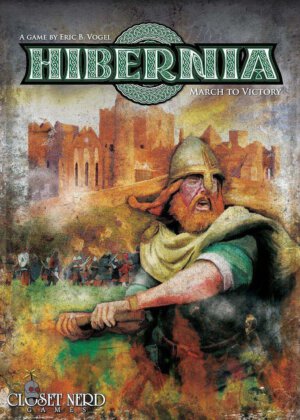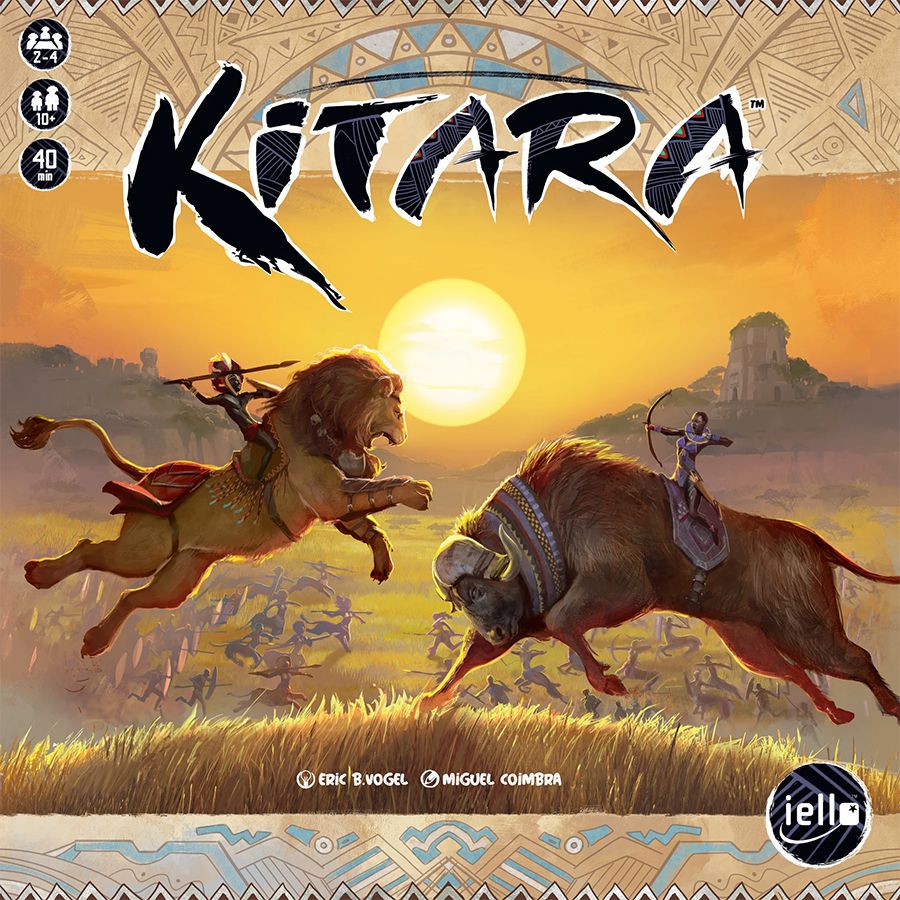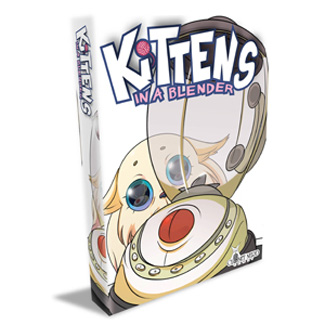
Publisher: Closet Nerd Games
Designer: Eric B. Vogel
Year: 2011
Players: Three to four players
Ages: 8+
Playing Time: 20-25 Minutes
Genre: Abstract wargame set in ancient Ireland
MSRP: $19.99
Hibernia is a game set in ancient Ireland, the chiefs of the four kingdoms vied for control of the land. The heads of Munster, Leinster, Connacht and Ulster used whatever means they could; be it diplomacy, intimidation, or sheer force. With the blessing of the druids, they waged their wars with hopes to one day be crowned high king of Hibernia.
In Hibernia, players march armies into colored regions each representing a different county of ancient Ireland. Occupy the right color combinations of counties to advance your marker around the score tracker. The first player to circle the board wins.
The components are serviceable as you receive 56 wooden warrior markers (or what we in the biz like to refer to as cubes…), one custom wooden die, one wooden start pawn, a game board that’s around a foot wide by a foot and a half high, and six pages of rules. Nothing really stands out but then again nothing is really cheesy so that’s why I’ll say they’re serviceable. I really didn’t care for the wooden die that much since it simply has colored stickers attached but what do you want for less than twenty bucks? I do like the fact the game itself, as well as the box has a small footprint so you can easily toss it into a backpack or glove compartment to take on the go.
The game is designed for play with three to four players but seems like it plays best with the full complement of four. I understand there’s a two player variant but I haven’t peeked at that as of yet. Learning the rules takes only a few minutes and most games, even with four players should be played to completion within 15-20 minutes or so.
Setup is quick as each player selects a color and takes those cubes, I mean warriors, of that color. Then they place one of their warriors on the start space of the scoring track that runs around the board. Then all the players kick in one of their warriors to be randomly drawn and placed on one of the four castle areas of the game board, as these will make for each clan’s starting area. The first player places three cubes on Celtic circle symbol of the board while the second player follows with two warriors in the circle. The third player places one warrior in the circle while the fourth gets nothing. Nada! Play will proceed to left from the start player.

Every turn players also receive a free march, as if they rolled a black result into any color county they’d like.
Combat is pretty simple and hardly problematic. If you march into a county that is occupied by enemy cubes, you exchange them on a 1 for 1 basis– so it’s a good idea to invade occupied real estate with more than they have present. Dead cubes go to the Celtic circle, to be reinforcements at a later time. The active player can use one of their two actions – either the die roll the free move- to return all of her own deceased warriors to their supply. All other players return half their warriors (rounded down) from the Valhalla area to their supplies when a player decides to raise warriors.
Scoring is the possibly the most interesting, while at the same time head scratch inducing, aspects of Hibernia. A track runs along the edge of the board where each player can move his or her score marker. The track is made up of various colors from the map of Ireland itself and the colors are staggered to some extent; sometimes two colors are back to back while in other sections interspersed. At the end of each turn, the player advances the score marker along the track matching the colors in regards to counties they control. I’ll use this example: let’s say you’re sitting on a blue space and the next spaces you see on the track are yellow, red, green, and green. Now you know that the next time you get to roll the bone you’re shooting to have units occupying one yellow, one red, and two blue counties to advance that distance. This allows you to sit and look at the scoring track to see exactly what your opponents need to do in order to advance to win the game.
As a straight Euro game with an area control mechanic I find it to be pretty interesting. As a game that’s being touted as a light wargame with Eurostyle mechanics I see it as a cheat.
There’s the rub. As a nice quick game to wind up or wind down an evening of heavy gaming with your pals, Hibernia is a fun play. On the flip side, the theme of trying to conquer ancient Ireland never comes across as it doesn’t really matter what counties you control as long as they help to advance you along the scoring track. We could be talking about a game that’s set as space colonies, or oil companies, or even a pennant race in baseball and it would play out the same. No wargamer, of any stripe, would ever think that only looking to control different sections of the map – and abandoning those already conquered – would fly.
This leads me to a very tricky area as a reviewer.
Hibernia is fun. It also has a lot going for it as an entertaining play as designer Eric Vogel is on to something here. But Hibernia is not properly themed or represented to the gaming public and part of that may be due to issues Eric has had with publishers or distributors or the like. I can’t say.
As a very abstract game, regardless of theme, I’d say you need to have Hibernia on your shelf just because it travels really well and is a good time. As something that is supposedly a historically based game, where you have a feel and narrative of leading a clan trying to unite Ireland, I’m just not feeling the love…
[rwp-review id=”0″]



















Thanks for looking at the game guys. A small point of fact, the die is painted not stickered.
Sorry Eric. For some reason I thought they were stickers but I have to say I didn’t focus on it that much when we were playing.
The scoring mechanic sounds really interesting, especially for denial of land access for your opponent to keep him/her from winning
It is an interesting mechanic and the game is fun for the most part. Just not a wargame I have to say.